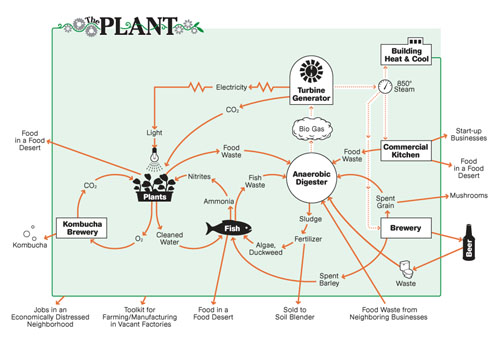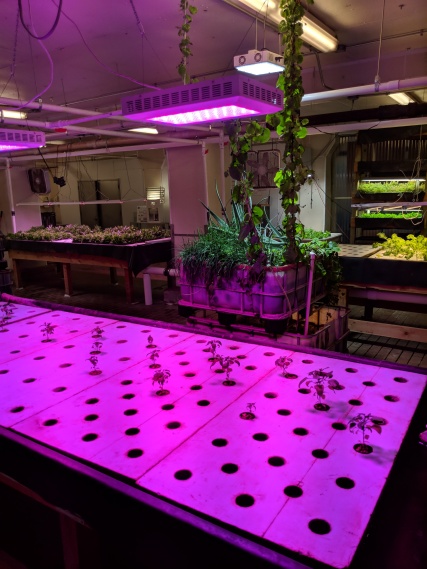Last week, HEEA (Harris Environment & Energy Association) hopped on the Magic School Bus and took a field trip to The Plant Chicago. It was a Ms. Frizzle adventure diving into the latest implementation of closed loop sustainable farming right in the middle of what used to be the heart of the nation’s goriest stockyards in the middle of Back of the Yards neighborhood, the center of the meatpacking industry. As we drove in, we were reminded that this legacy lives on with the towering fat rendering facility were thousands of pounds of fat are still processed to be used in soap, make-up, and crayons in name your favorite brands.
The building itself previously packed tons of pork and beef a day. Bubbly Dynamics, the development company, brought in the half a million dollar investment needed to undertake the refurbishment of the building. They refurbished it to bring it up to code and add pizzazz, but remnants of the building’s previous life remained, such as smoke rooms to cure meat which now served as conference rooms and baños.
Circular Economy
Bubbly Dynamics had the extraordinary vision to bring in different businesses that could mutually benefit one another to create a circular economy. Each has a sustainable aspect to it and as a whole they support one another. My favorite company was Just Ice which makes, you guessed it, ice. Meant for the cocktail bars across Chicago, the blocks of ice they produce are a thing of beauty. Especially if you’re interested in the enigmatic process of how to create clear ice. Shipping out ice was a callback to the olden days when shipping it down river from up north was the only way to get it. The other businesses revolve around food and included a bakery, ice cream maker, and coffee roaster. The development company did an excellent job of strategically bringing in businesses who could support one another instead of haphazardly bringing in whomever could pay rent. This is the Circular Economy in action.
Closed Loop Indoor Farming

The second part of the grand plan is closed loop indoor farming. Plant Chicago is the non-profit within The Plant building which helps educate and promote sustainability and close loop, zero waster food production. The main cycle created and exploited is between plants hydroponically growing in water and that water cycling through to fish. The fish create the ammonia which gets turned into nitrogen (with the help of bacteria) that the plants need. In return, the fish receive clean, oxygenated water. Some of the small businesses in the building are operating this or similar systems in the building to grow food for-profit.


Plant Chicago is a test bed for improving this system. For example, they have experimented with growing fruit fly larvae the fish can eat (didn’t work well, too smelly), testing different ways to start the seedlings, and testing the Kratsky Method of feeding plants. This expertise and knowledge gained becomes knowledge shared with others looking to implement similar systems through the outreach efforts that the non-profit puts on.
The Future
The Plant is continuing to evolve and ever looking for ways to grow. They still have space to bring in new businesses that fit within their tenant profile. They’re looking into putting in a shared kitchen, another excellent implementation of different stakeholders coming together for their mutual benefit. Their biggest initiative in progress is installing an anaerobic digester. This is a massive piece of metal tubing which allows for bacteria to break down waste in an oxygen-less environment to create biogas for energy and more productive waste. An interesting piece of information we learned was that Chicago’s Jardine Waste Water Treatment Plant has an anaerobic digester, but its output can’t be used for growing food since human waste contains too much chemicals and drugs. This means that besides the biogas produced for energy, it only gets used for landfill. Weird to think about! Gross!
Takeaways
The field trip was an excellent opportunity to supplement our education with something I feel is often lacking at the University of Chicago, implementation of solutions in the real-world. Takeaways in sustainable system implementations include:
- Have a bold vision – The Plant Chicago came out of an old building which was completely re-purposed. This took a lot of foresight to make this happen. The ability to envision what could be is an extraordinary ability.
- Look for symbiotic benefits – Many times the system as a whole with each part supporting one another can be successful where one would fail if operating alone.
- Try it out – Build something and don’t be afraid to fail. A lot can be learned by testing and prototyping. As Ms. Frizzle says, “Take chances, make mistakes, and get messy!”

Enter a caption

